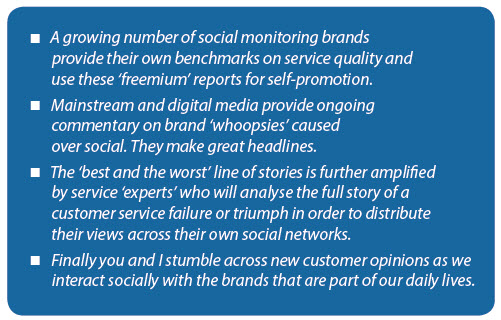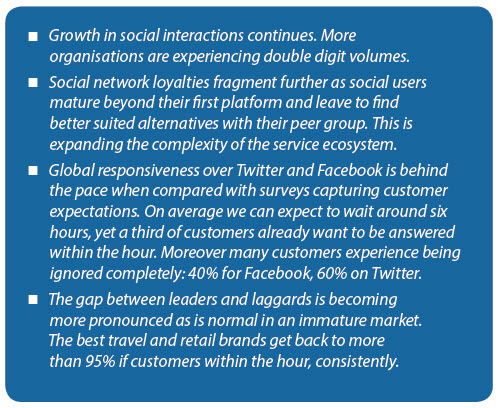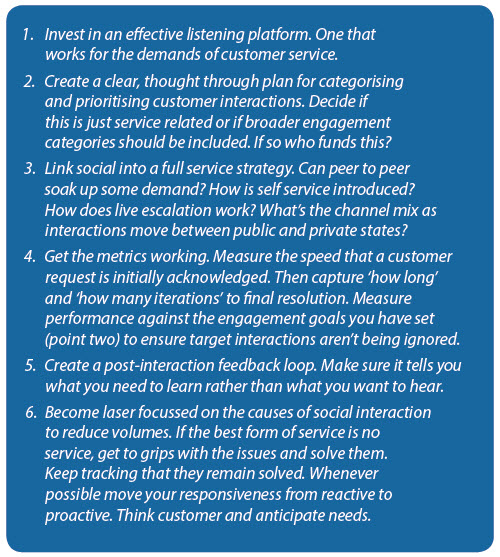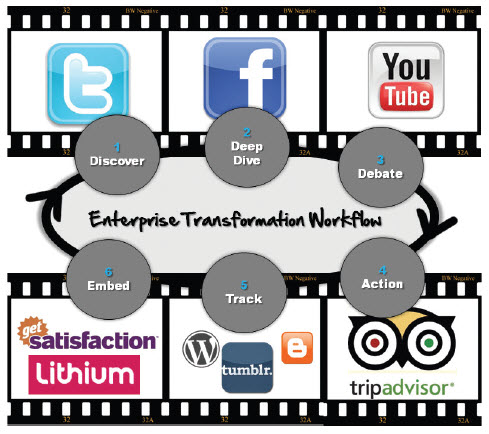
The growth of customer service via social channels is still in its infancy.
That said, it has made incredible strides over the last few years. From a scarcely noticed category of social engagement managed by non-customer service teams to the emerging model we see today. Slowly but surely, social customer service is being fitted into the discipline and infrastructure of multi-channel customer service.
As with many new competencies, market uptake has been spotty. As a rule of thumb, those markets right in the eye of the digital disruption storm are most advanced. Extensive customer migration to digital, social and mobile has catalysed their learning curve ahead of others. Retail and Travel are two obvious examples.
In these cases, the use of dedicated social customer service teams and some form of specialist workflow are most likely to have appeared. Most will now be a few years into their game plan. No doubt they will have learnt the importance of getting the recruitment profile right, winning the argument that Marketing and PR social technologies are not fit for purpose and got to grips with SLA expectations and the growing issue of how to scale social engagement.
Meanwhile other markets are still blinking in the sunlight, unable to focus on anything beyond a sense of unease that they are up and running on Twitter and Facebook without any great confidence that they know what they are doing.
Social Interaction Opens A New Chapter
While it’s true that social is just another set of channels. It is also true that the culture of social customer service is a line in the sand in terms of brand impact. While customer service has always impacted customer experience, it has been largely invisible to organisations. Thus out of sight, out of mind. That this is no longer the case is yet to be universally appreciated. But social customer service is now a spectator sport. The evidence is all around us.
Customer Service is the new Marketing. So says the slogan. It now has an impact because it is visible, searchable and a public commodity that can be amplified at will. This dynamic is what makes social engagement so interesting. The consequences of getting customer service journeys right and wrong are now stacked. The goodwill barometer is in constant motion as brand equity is added and subtracted in real time.
The rise of visible consequences cannot be over-estimated. Traditional (aka private) customer service has been a thirty year story of taking the flak on behalf of the organisation and often being shot as the messenger. But now social networks provide a living archive which social monitoring tools can mine for insight. Moreover the cost of investing in customer analytics is no longer a legitimate consideration. Every organisation can find one that suits their pockets.
This changes another fundamental in terms of Customer Services’ internal social standing. Instead of being seen as separate and removed from the core commercial goals of the organisation, they become an indispensable partner. Others start to recognise that their work is noticed by customers who become more or less likely to do business as a result. CS’s internal value is thus transformed.
Customer service teams that do social engagement well can expect to find all sorts of new friends and allies as a result. The smart ones will realise they can move away from the ‘tactical cost’ category into the ‘strategic value’ category. And with that upgraded status comes a fresh willingness to invest: one that has starved the customer service industry for so long in terms of recruiting top quality and developing smart service infrastructure.
At least that’s the optimistic version of where all this is trending.
This Year’s ‘Must Achieve’ Goals
All this brings us back to present time and the issue of how many organisations have yet to seize this opportunity and are delivering praiseworthy service experiences over social. While there is still some conflicting signals coming from social monitoring organisations as they standardise how they generate their benchmarks, a number of things are already clear.
Of course these high performing examples will cement expectations and cause a gradual standardisation over the next few years. Something all sectors will have to come to terms with. This will not be easy for some. Both in terms of catching up with the learning involved and also dealing with a scale of demand that is yet to manifest.
This expected upsurge is based not so much on any reputation that social customer service is better than legacy channels. Rather it reflects the momentum created from widespread smartphone and tablet ownership, combined with the ongoing deployment of faster and cheaper wireless access. This will continue to fuel growth in the next phase of social interaction between customers and their organisations as overall communication habits continue to transform.
So one of the key short term goals for any organisation involved in social customer service is getting to grips with the quality of their responsiveness. Here are some of the tasks involved.
For service organisations already up to speed on their responsiveness, they should consider turning up the volume on point number six. This is where the rubber hits the road in terms of the parent organisation being willing to accept ongoing customer inspired change. Of course all organisations face the prospect of extinction if they continue to ignore what is wanted of them by their customers. However in the past this drama could have played out over years and decades. Even centuries in extreme cases.
Not so today. Feedback is real time, at scale and decipherable. In an era of competitive social intelligence, we simply will not get away with ignoring customer insight before someone else steps in. This means we need to get used to continuously upgrading how organisations work based on what those real time market signals tell us. We can hear customers. We can see competitors. We can plug into expert commentary. What’s new? Where is the advantage? What now needs to happen to take advantage? We adapt or die. At a pace never before experienced.
Of course turning data into actionable insight is no accident. That’s why the best customer service teams will be sitting at the heart of these debates. They recognise that making improvements and sourcing innovation is a by product of providing social customer service. They organise to make that happen. They extend their internal networks to influence priorities. They embody the voice of the customer being closest to its source.
This is where the second wave of customer service transformation is now heading to.
Concluding Thought
Of course this view of life sits strangely with current realities. Call centres are deeply conservative. Of necessity, they have been in survival mode for most of their existence and so have modest agendas. In this respect, social customer service brings as much advantage to the call centre as it does to the customer. It breaks the mould. From which something new can emerge.
For leaders who are impatient for that future, they can start today by setting a new standard within their front line communicators and performance coaches.The whole opportunity to drive extra brand value comes down to a smart integrated service strategy and how that team behaves.









Martin,
Interesting article, though I have to admit to being a bit flat earth about social media.
For me the issue isn’t the technology, social media, e-mail, telephone… The issue is how do we treat and respond to our customers. In that regard I don’t think the challenges have changed much.
After all human beings behave as human beings.
James
Martin,
I would agree that it’s an important issue. However, I think that the only thing that is certain is that things will continue to change. Therefore, I would suggest the central issue is one of how firms respond to their changing customer and competitive environments and not just one that is limited to social customer service. I feel that it may be the catalyst and the one that causes the pain but change, whole organisational change and the ability to change quickly and effectively, I believe, will become more and more of a competitive advantage as we move forward.
Adrian